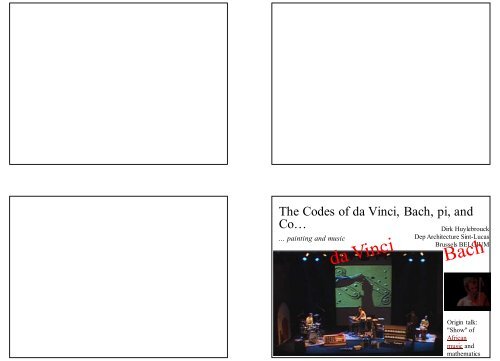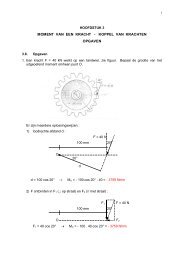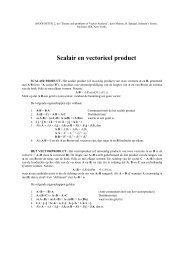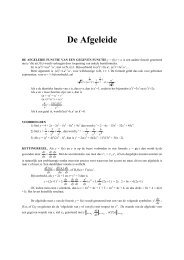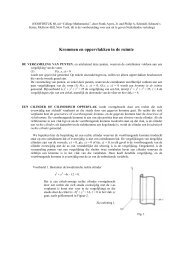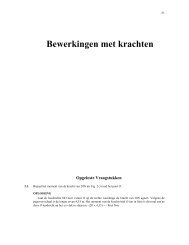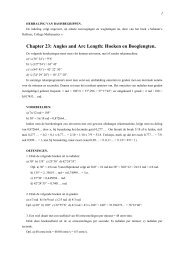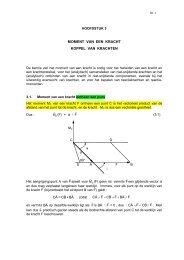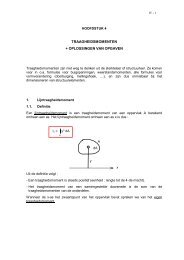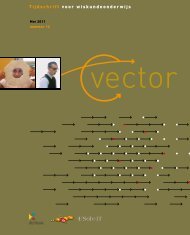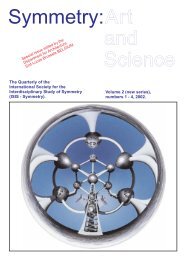The Codes of da Vinci, Bach, pi, and Co… - Sint-Lucas
The Codes of da Vinci, Bach, pi, and Co… - Sint-Lucas
The Codes of da Vinci, Bach, pi, and Co… - Sint-Lucas
You also want an ePaper? Increase the reach of your titles
YUMPU automatically turns print PDFs into web optimized ePapers that Google loves.
<strong>The</strong> <strong>Codes</strong> <strong>of</strong> <strong>da</strong> <strong>Vinci</strong>, <strong>Bach</strong>, <strong>pi</strong>, <strong>and</strong><br />
<strong>Co…</strong><br />
… painting <strong>and</strong> music<br />
Dirk Huylebrouck<br />
Dep Architecture <strong>Sint</strong>-<strong>Lucas</strong><br />
Brussels BELGIUM<br />
Origin talk:<br />
"Show" <strong>of</strong><br />
African<br />
music <strong>and</strong><br />
mathematics
1) Douglas H<strong>of</strong>stadter: “Gödel, Escher, <strong>Bach</strong>,<br />
an eternal golden braid”<br />
Kunst<br />
der Füge<br />
1) Douglas H<strong>of</strong>stadter: “Gödel, Escher, <strong>Bach</strong>,<br />
an eternal golden braid”<br />
Kunst<br />
der Füge<br />
1) Douglas H<strong>of</strong>stadter: “Gödel, Escher, <strong>Bach</strong>,<br />
an eternal golden braid”<br />
M.C.<br />
Escher's<br />
"Reptiles,"<br />
modified<br />
for quilts<br />
by Kay<br />
Parker in<br />
her<br />
book<br />
"Contemporary<br />
Quilts".<br />
Kunst<br />
der Füge<br />
1) Douglas H<strong>of</strong>stadter: “Gödel, Escher, <strong>Bach</strong>,<br />
an eternal golden braid”<br />
Picture<br />
<strong>of</strong> the<br />
UN in<br />
NY<br />
ins<strong>pi</strong>red<br />
by<br />
Escher<br />
Kunst<br />
der Füge
Footprints in ash <strong>and</strong> pumice <strong>da</strong>ted to 385,000 to 325,000 years<br />
ago on the slopes <strong>of</strong> the Roccamonfina volcano in southern Italy.<br />
France's "Grotte Chauvet" up to 32,000 years ago (horses).<br />
2) Dawn<br />
43000 - 82000<br />
years old<br />
Ne<strong>and</strong>erthal<br />
flute, Slovenia<br />
2) Dawn<br />
43000 - 82000<br />
years old<br />
Ne<strong>and</strong>erthal<br />
flute, Slovenia<br />
Tiny 77000-years-old stone from the Lebombo<br />
Mountains in South Africa<br />
25000 years old<br />
“key-pattern” from<br />
Mezin, Ukraine<br />
2) Dawn<br />
43000 - 82000<br />
years old<br />
Ne<strong>and</strong>erthal<br />
flute, Slovenia<br />
2) Dawn<br />
43000 - 82000<br />
years old<br />
Ne<strong>and</strong>erthal<br />
flute, Slovenia
3) From Africa over the Middle East to Greece<br />
Structural<br />
properties<br />
music in<br />
Africa:<br />
1 Hemiola<br />
2 Additive<br />
rhythm<br />
3 Gestalt<br />
Rujindiri<br />
Rwan<strong>da</strong><br />
3) From Africa over the Middle East to Greece<br />
Structural<br />
properties<br />
music in<br />
Africa:<br />
1 Hemiola<br />
2 Additive<br />
rhythm<br />
3 Gestalt<br />
Rujindiri<br />
Rwan<strong>da</strong><br />
3) From Africa over the Middle East to Greece<br />
Proportions?<br />
Structural<br />
properties<br />
music in<br />
Africa:<br />
1 Hemiola<br />
2 Additive<br />
rhythm<br />
3 Gestalt<br />
Rujindiri<br />
Rwan<strong>da</strong><br />
3) From Africa over the Middle East to Greece<br />
“Ostrakas" in what is now called ‘Iraq’<br />
Structural<br />
properties<br />
music in<br />
Africa:<br />
1 Hemiola<br />
2 Additive<br />
rhythm<br />
3 Gestalt<br />
Rujindiri<br />
Rwan<strong>da</strong>
4) Greece: Euclide, Parthenon, Cithar<br />
do<br />
re<br />
mi<br />
fa<br />
sol<br />
la<br />
si<br />
do<br />
1:1<br />
9:8<br />
81:64<br />
4:3<br />
3:2<br />
27:16<br />
243:128<br />
2:1<br />
Delphi stone<br />
with music<br />
notation <strong>of</strong><br />
the hymn.<br />
4) Greece: Euclide, Parthenon, Cithar<br />
do<br />
re<br />
mi<br />
fa<br />
sol<br />
la<br />
si<br />
do<br />
1:1<br />
9:8<br />
81:64<br />
4:3<br />
3:2<br />
27:16<br />
243:128<br />
2:1<br />
Delphi stone<br />
with music<br />
notation <strong>of</strong><br />
the hymn.<br />
4) Greece: Euclide, Parthenon, Cithar<br />
do<br />
re<br />
mi<br />
fa<br />
sol<br />
la<br />
si<br />
do<br />
1:1<br />
9:8<br />
81:64<br />
4:3<br />
3:2<br />
27:16<br />
243:128<br />
2:1<br />
Delphi stone<br />
with music<br />
notation <strong>of</strong><br />
the hymn.<br />
4) Greece: Euclide, Parthenon, Cithar<br />
Roger Herz-Fischler 1987; George Markowsky, 1992<br />
do<br />
re<br />
mi<br />
fa<br />
sol<br />
la<br />
si<br />
do<br />
1:1<br />
9:8<br />
81:64<br />
4:3<br />
3:2<br />
27:16<br />
243:128<br />
2:1<br />
Delphi stone<br />
with music<br />
notation <strong>of</strong><br />
the hymn.
5) Fibonacci, cathedrals, kyries<br />
d 1:1<br />
e 9:8<br />
f 32:27<br />
fis 81:64<br />
g 4:3<br />
a 3:2<br />
b 27:16<br />
c 16:9<br />
cis 243:128<br />
d' 2:1<br />
Stacking up<br />
tones in the<br />
medieval<br />
tone<br />
"system" or<br />
… working<br />
without it.<br />
5) Fibonacci, cathedrals, kyries<br />
d 1:1<br />
e 9:8<br />
f 32:27<br />
fis 81:64<br />
g 4:3<br />
a 3:2<br />
b 27:16<br />
c 16:9<br />
cis 243:128<br />
d' 2:1<br />
Stacking up<br />
tones in the<br />
medieval<br />
‘system’ or<br />
… working<br />
without a<br />
‘system’.<br />
5) Fibonacci, cathedrals, kyries<br />
d 1:1<br />
e 9:8<br />
f 32:27<br />
fis 81:64<br />
g 4:3<br />
a 3:2<br />
b 27:16<br />
c 16:9<br />
cis 243:128<br />
d' 2:1<br />
Stacking up<br />
tones in the<br />
medieval<br />
‘system’ or<br />
… working<br />
without a<br />
‘system’.<br />
5) Fibonacci, cathedrals, kyries<br />
d 1:1<br />
e 9:8<br />
f 32:27<br />
fis 81:64<br />
g 4:3<br />
a 3:2<br />
b 27:16<br />
c 16:9<br />
cis 243:128<br />
d' 2:1<br />
Stacking up<br />
tones in the<br />
medieval<br />
‘system’ or<br />
… working<br />
without a<br />
‘system’.
6) Pacioli, Brunelleschi, simplified ratios<br />
Filippo Brunelleschi, San Lorenzo, 1440.<br />
do<br />
re<br />
mi<br />
fa<br />
sol<br />
la<br />
si<br />
do<br />
1:1<br />
9:8<br />
5:4<br />
4:3<br />
3:2<br />
5:3<br />
15:8<br />
2:1<br />
Simplifying<br />
ratios in<br />
tackling the<br />
Pythagorean<br />
comma<br />
problem<br />
6) Pacioli, Brunelleschi, simplified ratios<br />
Borromini gallery,<br />
as a transportable<br />
"blow up 'play'<br />
castle"<br />
do<br />
re<br />
mi<br />
fa<br />
sol<br />
la<br />
si<br />
do<br />
1:1<br />
9:8<br />
5:4<br />
4:3<br />
3:2<br />
5:3<br />
15:8<br />
2:1<br />
Simplifying<br />
ratios in<br />
tackling the<br />
Pythagorean<br />
comma<br />
problem<br />
Dutch artists<br />
Vredeman de Vries<br />
±1550<br />
6) Pacioli, Brunelleschi, simplified ratios<br />
do<br />
re<br />
mi<br />
fa<br />
sol<br />
la<br />
si<br />
do<br />
1:1<br />
9:8<br />
5:4<br />
4:3<br />
3:2<br />
5:3<br />
15:8<br />
2:1<br />
Simplifying<br />
ratios in<br />
tackling the<br />
Pythagorean<br />
comma<br />
problem<br />
6) Pacioli, Brunelleschi, simplified ratios<br />
1413: Brunelleschi veroorzaakte volkstoeloop op San<br />
Giovanniplein in Firenze met perspectieftekening<br />
do<br />
re<br />
mi<br />
fa<br />
sol<br />
la<br />
si<br />
do<br />
1:1<br />
9:8<br />
5:4<br />
4:3<br />
3:2<br />
5:3<br />
15:8<br />
2:1<br />
Simplifying<br />
ratios in<br />
tackling the<br />
Pythagorean<br />
comma<br />
problem
Rembr<strong>and</strong>t, <strong>The</strong> Night Watch,<br />
1642 (Amster<strong>da</strong>m).<br />
Johannes<br />
Vermeer<br />
1632 - 1675<br />
Girl with a<br />
pearl earring<br />
7) Newton, Vermeer, <strong>Bach</strong><br />
do<br />
1<br />
re 1.118… = √5/2<br />
mi 1.25 = (√5/2)<br />
… ?!<br />
Music studies in<br />
centre <strong>of</strong> attention:<br />
mean tone scales, etc<br />
music geometry<br />
2<br />
Before:<br />
1:1<br />
do<br />
9:8=1.125<br />
re<br />
5:4=1.25<br />
…<br />
mi<br />
Now:<br />
7) Newton, Vermeer, <strong>Bach</strong><br />
do<br />
re<br />
mi<br />
…<br />
1<br />
1.118… = √5/2<br />
1.25 = (√5/2) 2<br />
Music studies in<br />
centre <strong>of</strong> attention:<br />
mean tone scales, etc<br />
music geometry<br />
Aldert Mantje & Jan Maris:<br />
Night Watch Research Project<br />
www.verbekefoun<strong>da</strong>tion.com/<br />
Influence science & technology:<br />
linseed (flax seed) replaces egg<br />
tempera paint; lenses <strong>and</strong><br />
mirrors: chiaroscuro (clair<br />
obsur), geometric composition ...<br />
<strong>The</strong> Anatomy Lesson<br />
<strong>of</strong> Dr. Nicolaes Tulp<br />
(Rembr<strong>and</strong>t)<br />
7) Newton, Vermeer, <strong>Bach</strong><br />
do<br />
re<br />
mi<br />
…<br />
1<br />
1.118… = √5/2<br />
1.25 = (√5/2) 2<br />
Music studies in<br />
centre <strong>of</strong> attention:<br />
mean tone scales, etc<br />
music geometry<br />
7) Newton, Vermeer, <strong>Bach</strong><br />
do<br />
re<br />
mi<br />
…<br />
1<br />
1.118… = √5/2<br />
1.25 = (√5/2) 2<br />
Music studies in<br />
centre <strong>of</strong> attention:<br />
mean tone scales, etc<br />
music geometry
John Constable, Dedham Vale 1802<br />
Adolph von Menzel, Flötenkonzert 1850-52<br />
8) Gauss, J-F Millet, 2 1/12 relation.<br />
do<br />
1:1<br />
re 1.118 = √5/2<br />
mi 1.25 = (√ (√5/2) (√<br />
… ???<br />
2<br />
Before:<br />
Now:<br />
do<br />
re<br />
mi<br />
fa<br />
sol<br />
la<br />
si<br />
do<br />
1<br />
1.122…=2 2/12<br />
1.259…=2 4/12<br />
1.334…=2 5/12<br />
1.498…=2 7/12<br />
1.681…=2 9/12<br />
1.887…=2 11/12<br />
One mathematical<br />
rule explains all<br />
music notes<br />
8) Gauss, J-F Millet, 2 1/12 relation.<br />
do<br />
re<br />
mi<br />
fa<br />
sol<br />
la<br />
si<br />
do<br />
2<br />
1<br />
1.122…=2 2/12<br />
1.259…=2 4/12<br />
1.334…=2 5/12<br />
1.498…=2 7/12<br />
1.681…=2 9/12<br />
1.887…=2 11/12<br />
2<br />
One mathematical<br />
rule explains all<br />
music notes<br />
Jacques-Louis David, La mort de Socrate 1787<br />
8) Gauss, J-F Millet, 2 1/12 relation.<br />
do<br />
re<br />
mi<br />
fa<br />
sol<br />
la<br />
si<br />
do<br />
1<br />
1.122…=2 2/12<br />
1.259…=2 4/12<br />
1.334…=2 5/12<br />
1.498…=2 7/12<br />
1.681…=2 9/12<br />
1.887…=2 11/12<br />
2<br />
One mathematical<br />
rule explains all<br />
music notes<br />
8) Gauss, J-F Millet, 2 1/12 relation.<br />
Jean-François<br />
Millet, <strong>The</strong><br />
Gleaners<br />
(1857), a<br />
realistic<br />
painting,<br />
applying all<br />
known<br />
techniques<br />
before<br />
photography.<br />
do<br />
re<br />
mi<br />
fa<br />
sol<br />
la<br />
si<br />
do<br />
1<br />
1.122…=2 2/12<br />
1.259…=2 4/12<br />
1.334…=2 5/12<br />
1.498…=2 7/12<br />
1.681…=2 9/12<br />
1.887…=2 11/12<br />
2<br />
One mathematical<br />
rule explains all<br />
music notes
Georges Seurat, Sun<strong>da</strong>y Afternoon on the Isl<strong>and</strong> <strong>of</strong> La<br />
Gr<strong>and</strong>e Jatte 1886<br />
Georges Seurat, Sun<strong>da</strong>y Afternoon on the Isl<strong>and</strong> <strong>of</strong> La<br />
Gr<strong>and</strong>e Jatte 1886<br />
Georges Seurat, La Parade, 1889<br />
9) Cantor, Seurat, Hertz.<br />
do 261.63 Hz<br />
re 293.66 Hz<br />
mi 329.63 Hz<br />
fa 349.23 Hz<br />
sol 392 Hz<br />
la 440 Hz<br />
si 493.88 Hz<br />
do 523.25 Hz<br />
Some label<br />
Anton<br />
Webern’s<br />
“Concerto for<br />
Nine<br />
Instruments”<br />
pointillist.<br />
9) Cantor, Seurat, Hertz.<br />
do 261.63 Hz<br />
re 293.66 Hz<br />
mi 329.63 Hz<br />
fa 349.23 Hz<br />
sol 392 Hz<br />
la 440 Hz<br />
si 493.88 Hz<br />
do 523.25 Hz<br />
Some label<br />
Anton<br />
Webern’s<br />
“Concerto for<br />
Nine<br />
Instruments”<br />
pointillist.<br />
<strong>The</strong>odoor van<br />
Rysselberghe,<br />
Portrait <strong>of</strong> Alice<br />
Sethe, 1888<br />
After Georges Seurat, La Parade, 1889<br />
9) Cantor, Seurat, Hertz.<br />
do 261.63 Hz<br />
re 293.66 Hz<br />
mi 329.63 Hz<br />
fa 349.23 Hz<br />
sol 392 Hz<br />
la 440 Hz<br />
si 493.88 Hz<br />
do 523.25 Hz<br />
Some label<br />
Anton<br />
Webern’s<br />
“Concerto for<br />
Nine<br />
Instruments”<br />
pointillist.<br />
9) Cantor, Seurat, Hertz.<br />
do 261.63 Hz<br />
re 293.66 Hz<br />
mi 329.63 Hz<br />
fa 349.23 Hz<br />
sol 392 Hz<br />
la 440 Hz<br />
si 493.88 Hz<br />
do 523.25 Hz<br />
Some label<br />
Anton<br />
Webern’s<br />
“Concerto for<br />
Nine<br />
Instruments”<br />
pointillist.
Pablo Picasso, <strong>The</strong> Bull lithographies, 1945.<br />
Georges Braque, Violin <strong>and</strong> C<strong>and</strong>lestick, 1910.<br />
10) Einstein, Picasso, Grisey.<br />
Helmholtz:<br />
consonance<br />
= overlap<br />
overtones,<br />
in ear <strong>of</strong><br />
observer.<br />
Applied by<br />
composer<br />
Gérard<br />
Grisey<br />
founder <strong>of</strong><br />
spectralism.<br />
10) Einstein, Picasso, Grisey.<br />
Helmholtz:<br />
consonance<br />
= overlap<br />
overtones,<br />
in ear <strong>of</strong><br />
observer.<br />
Applied by<br />
composer<br />
Gérard<br />
Grisey<br />
founder <strong>of</strong><br />
spectralism.<br />
Pablo Picasso,, Les Demoiselles d'Avignon, 1907<br />
10) Einstein, Picasso, Grisey.<br />
Helmholtz:<br />
consonance<br />
= overlap<br />
overtones,<br />
in ear <strong>of</strong><br />
observer.<br />
Applied by<br />
composer<br />
Gérard<br />
Grisey<br />
founder <strong>of</strong><br />
spectralism.<br />
10) Einstein, Picasso, Grisey.<br />
Uit “Aldo Van Eyck”:<br />
[…] Hieruit hoeft<br />
echter niet<br />
geconcludeerd te<br />
worden <strong>da</strong>t het<br />
kubisme beïnvloed<br />
werd door de<br />
relativiteitstheorie.<br />
Einstein formuleerde de bijzondere relativiteitstheorie (1905)<br />
weliswaar vóór het kubisme tot bloei kwam (1910-11), maar deze<br />
bloei werd uiteraard voorafgegaan door een ontluiking. De<br />
nieuwe, relativistische wijze van zien tekent zich in de<br />
schilderkunst reeds twintig jaar eerder af, met name in het werk<br />
van Cézanne. Bovendien maakt de bijzondere relativiteitstheorie<br />
de werkelijkheid nog niet kenbaar als een complex energetisch<br />
veld. Deze opvatting van de werkelijkheid, die in het kubisme van<br />
1910 gestalte krijgt, vindt haar wetenschappelijke formulering pas<br />
in de algemene relativiteitstheorie, die Einstein in 1916 voltooide.<br />
Helmholtz:<br />
consonance<br />
= overlap<br />
overtones,<br />
in ear <strong>of</strong><br />
observer.<br />
Applied by<br />
composer<br />
Gérard<br />
Grisey<br />
founder <strong>of</strong><br />
spectralism.
Vasarely, Stri<br />
Neu. Some speak<br />
<strong>of</strong> colloï<strong>da</strong>l art,<br />
<strong>and</strong> make<br />
comparisons with<br />
chemical to<strong>pi</strong>cs<br />
11) Russell, Vasarelly, sound illusion.<br />
perception<br />
11) Russell, Vasarelly, sound illusion.<br />
perception<br />
Sound illusions<br />
Sound illusions<br />
Bridget Riley,<br />
Movement in<br />
Squares, 1961.<br />
11) Russell, Vasarelly, sound illusion.<br />
perception<br />
11) Russell, Vasarelly, sound illusion.<br />
perception<br />
Sound illusions<br />
Sound illusions
12) Schrödinger, Pollock, Xenakis.<br />
Jack <strong>The</strong> Dripper.<br />
12) Schrödinger, Pollock, Xenakis.<br />
CD collection jazz Pollock<br />
allegedly listened to while<br />
painting. Is it art?<br />
Xenakis’<br />
musical<br />
pavilion in<br />
Brussels<br />
(1958) <strong>and</strong><br />
stochastic<br />
music.<br />
Xenakis’<br />
musical<br />
pavilion in<br />
Brussels<br />
(1958) <strong>and</strong><br />
stochastic<br />
music.<br />
12) Schrödinger, Pollock, Xenakis.<br />
Jackson Pollock, Lavender Mist 1950.<br />
12) Schrödinger, Pollock, Xenakis.<br />
Xenakis’<br />
musical<br />
pavilion in<br />
Brussels<br />
(1958) <strong>and</strong><br />
stochastic<br />
music.<br />
Xenakis’<br />
musical<br />
pavilion in<br />
Brussels<br />
(1958) <strong>and</strong><br />
stochastic<br />
music.
13) Finite geometry, minimal art, discrete-tones<br />
Jean-Marie Dendoncker (Belgium) is a<br />
carpenter – mathematician, who makes wooden<br />
models, for, for instance, an arrangement <strong>of</strong> 7<br />
points on 7 lines, 3 by 3.<br />
Twelve tone symmetry<br />
Xenakis's Bohor layout<br />
13) Finite geometry, minimal art, discrete-tones<br />
Carlo Sequin's (Berkeley) Minimal Trefoil<br />
Twelve tone symmetry<br />
Xenakis's Bohor layout<br />
13) Finite geometry, minimal art, discrete-tones<br />
ISIS<br />
Tihany<br />
2004<br />
Bukowsky<br />
Twelve tone symmetry<br />
Xenakis's Bohor layout<br />
13) Finite geometry, minimal art, discrete-tones<br />
Twelve tone symmetry<br />
Xenakis's Bohor layout
J.M.W. Turner, <strong>The</strong> fighting Téméraire tugged<br />
to her last Berth to be broken, 1839.<br />
Francisco de Goya y Lucientes, <strong>The</strong> Third <strong>of</strong><br />
May, 1808.<br />
14) Romanticism<br />
Young van Beethoven;<br />
Beethoven's third<br />
symphony = “good<br />
romantic style”<br />
14) Romanticism<br />
Young van Beethoven;<br />
Beethoven's third<br />
symphony = “good<br />
romantic style”<br />
Egide Charles Gustave Wappers, E<strong>pi</strong>sode <strong>of</strong> the<br />
Belgian Revolution <strong>of</strong> 1830, painted in 1834.<br />
Francisco de Goya y Lucientes, <strong>The</strong> Third <strong>of</strong><br />
May, 1808.<br />
Théodore Géricault, Raft <strong>of</strong> the Medusa, 1839.<br />
14) Romanticism<br />
Young van Beethoven;<br />
Beethoven's third<br />
symphony = “good<br />
romantic style”<br />
14) Romanticism<br />
Young van Beethoven;<br />
Beethoven's third<br />
symphony = “good<br />
romantic style”
Edgar Degas, La Classe de Danse, 1874<br />
Claude Monet, Impression, soleil levant, 1872<br />
15) Impressionism<br />
In Claude Debussy's<br />
time, nocturnes,<br />
arabesques <strong>and</strong> preludes<br />
became fashionable.<br />
15) Impressionism<br />
In Claude Debussy's<br />
time, nocturnes,<br />
arabesques <strong>and</strong> preludes<br />
became fashionable.<br />
Pierre-Auguste Renoir, Le Moulin de la<br />
Galette, 1876<br />
Monet’s Sunset changed to grey values: the<br />
disk <strong>of</strong> the sun disappears.<br />
15) Impressionism<br />
In Claude Debussy's<br />
time, nocturnes,<br />
arabesques <strong>and</strong> preludes<br />
became fashionable.<br />
15) Impressionism<br />
In Claude Debussy's<br />
time, nocturnes,<br />
arabesques <strong>and</strong> preludes<br />
became fashionable.
Tatlin<br />
Tower.<br />
Model <strong>of</strong><br />
the<br />
Monument<br />
to the Third<br />
International<br />
Construct<br />
ivists<br />
designed<br />
<strong>of</strong> posters<br />
for everything<br />
from film<br />
to propagan<strong>da</strong>;<br />
here:<br />
photomontage<br />
by Gustav<br />
Klutsis.<br />
16) Constructivism<br />
Alex<strong>and</strong>er Mosolov’s<br />
“Steel Foundry”<br />
introduced mechanical<br />
sounds.<br />
16) Constructivism<br />
Alex<strong>and</strong>er Mosolov’s<br />
“Steel Foundry”<br />
introduced mechanical<br />
sounds.<br />
Rodchenko, Stairway, 1930.<br />
Tatlin’s<br />
tribute to the<br />
working<br />
class.<br />
16) Constructivism<br />
Alex<strong>and</strong>er Mosolov’s<br />
“Steel Foundry”<br />
introduced mechanical<br />
sounds.<br />
16) Constructivism<br />
Alex<strong>and</strong>er Mosolov’s<br />
“Steel Foundry”<br />
introduced mechanical<br />
sounds.
Constant Permeke, <strong>The</strong> Daily Bread<br />
El Greco, View <strong>of</strong> Toledo, 1595-1610 resembles 20th<br />
cent. expressionism (art-historically: “mannerism”).<br />
17) Expressionism<br />
Schoenberg’ s opera<br />
“Erwartung” (1909) is<br />
called expressionist<br />
because <strong>of</strong> “screaming<br />
emotions” <strong>of</strong> the main<br />
character.<br />
17) Expressionism<br />
Schoenberg’ s opera<br />
“Erwartung” (1909) is<br />
called expressionist<br />
because <strong>of</strong> “screaming<br />
emotions” <strong>of</strong> the main<br />
character.<br />
Above: painting by Schoenberg’s friend<br />
K<strong>and</strong>insky; left: painting by the composer<br />
Schoenberg.<br />
Edvard<br />
Munch,<br />
<strong>The</strong><br />
Scream,<br />
1893;<br />
forerunner<br />
<strong>of</strong><br />
expressionism.<br />
17) Expressionism<br />
Schoenberg’ s opera<br />
“Erwartung” (1909) is<br />
called expressionist<br />
because <strong>of</strong> “screaming<br />
emotions” <strong>of</strong> the main<br />
character.<br />
17) Expressionism<br />
Schoenberg’ s opera<br />
“Erwartung” (1909) is<br />
called expressionist<br />
because <strong>of</strong> “screaming<br />
emotions” <strong>of</strong> the main<br />
character.
* Gödel Escher <strong>Bach</strong> in recent times?<br />
Victor Servranckx<br />
Le rectangle le plus<br />
carré, 1924<br />
new realism<br />
Luc Tuymans<br />
<strong>The</strong> Perfect Table<br />
Setting, 2004<br />
18) Continued?<br />
J. Cage, 1952:<br />
4’33”<br />
… <strong>of</strong> silence<br />
Popular<br />
music?<br />
* education?<br />
Going by<br />
the books?<br />
Or learning<br />
intuitively, as<br />
if it were a<br />
game?<br />
18) Continued?


